Why you can trust Tom's Hardware
Comparison Products
Today we put the 2TB Seagate IronWolf 525 against the Best SSDs on the market. For PCIe 4.0 competition, we threw in the Seagate FireCuda 530, WD_Black SN850, and Mushkin Gamma. We also threw in PCIe 3.0 comparisons, including the SK hynix Gold P31, Samsung 970 EVO Plus, Team Group T-Create Expert, and WD_Black SN750.
Trace Testing - 3DMark Storage Benchmark
Built for gamers, 3DMark’s Storage Benchmark focuses on real-world gaming performance. Each round in this benchmark stresses storage based on gaming activities including loading games, saving progress, installing game files, and recording gameplay video streams.
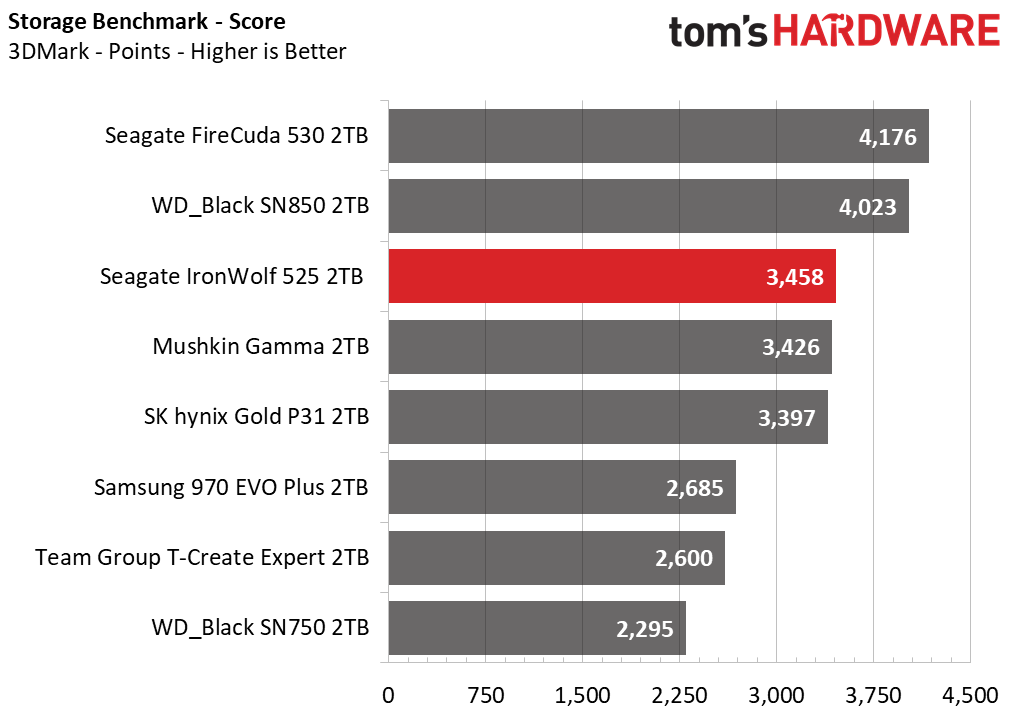
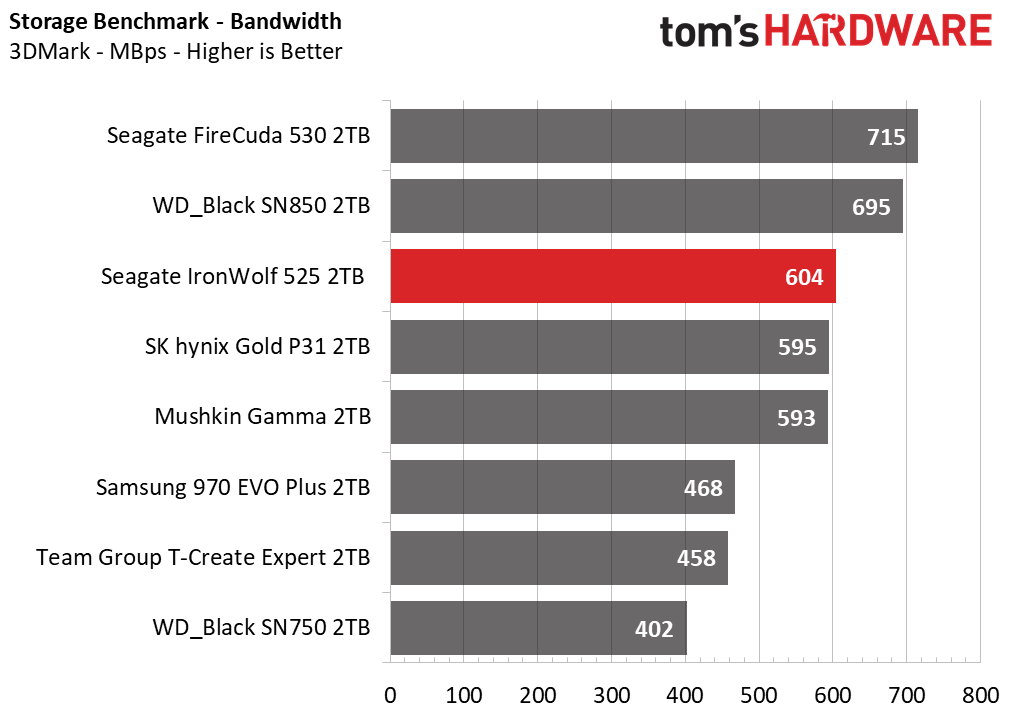
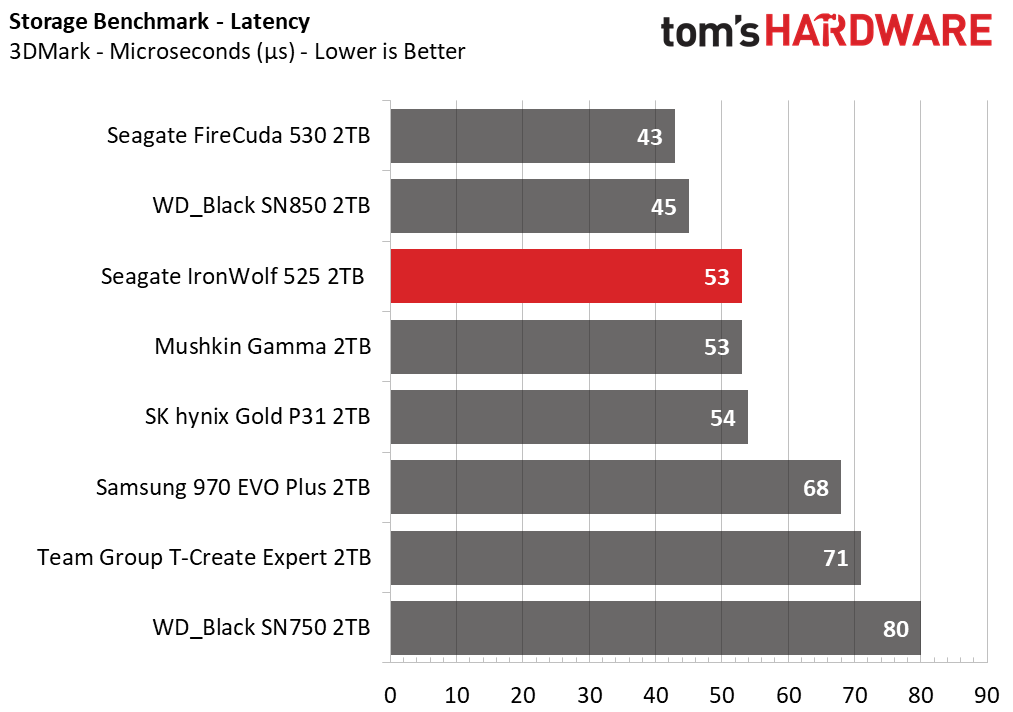
Seagate's FireCuda 530 and the WD Black SN850 delivered the fastest results in this benchmark, but Seagate's IronWolf 525 performed very well even though it is limited by its 5.0/4.4 GBps of bandwidth.
This test isn't relevant to a NAS use-case, but it is part of our standard test suite and does show how the drive performs in sporadic, bursty workloads. Obviously, Seagate's IronWolf 525 wasn't designed for gaming, but it managed third place. We have tests that will give us a better indication of performance with different file types below.
Trace Testing – PCMark 10 Storage Benchmark
PCMark 10 is a trace-based benchmark that uses a wide-ranging set of real-world traces from popular applications and everyday tasks to measure the performance of storage devices.
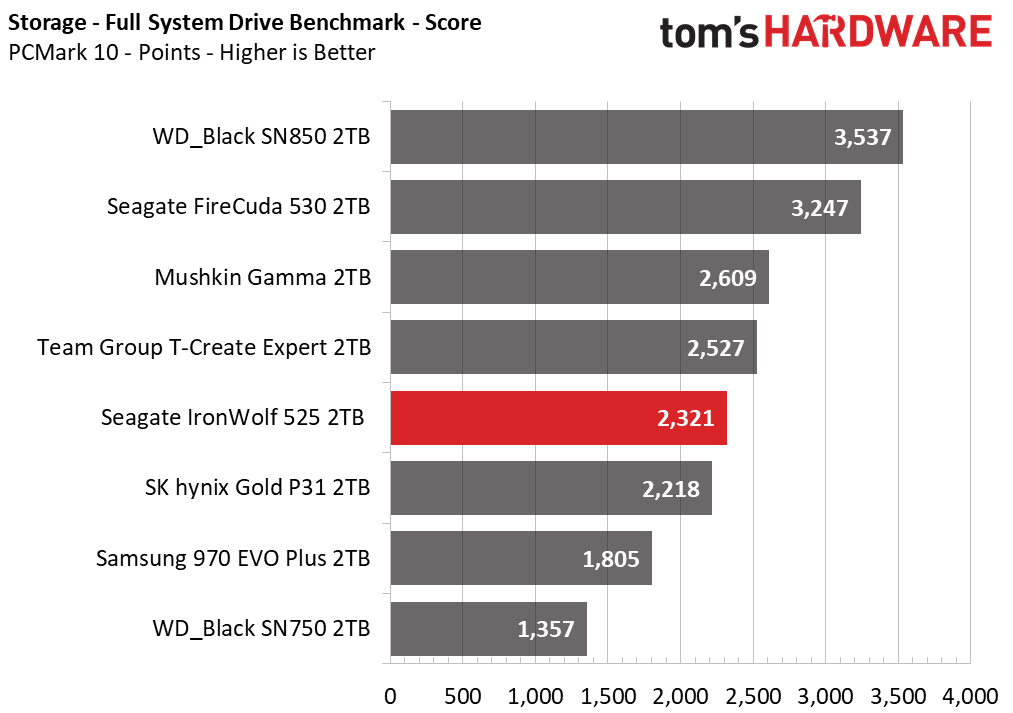
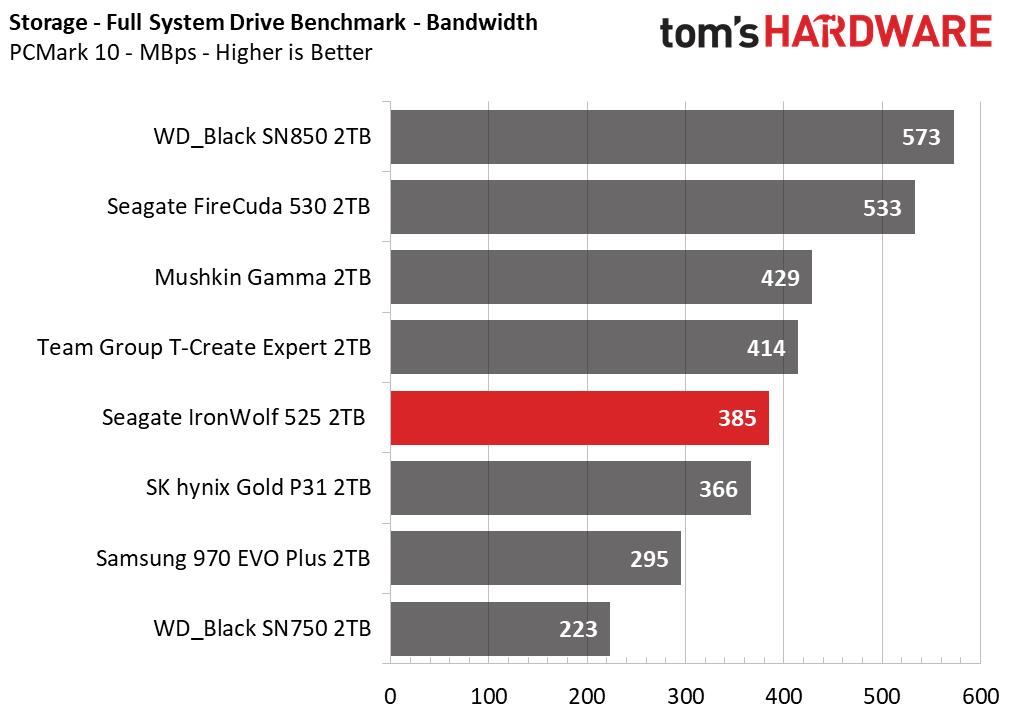

The IronWolf 525 wasn’t quite as responsive as its PCIe 4.0-equipped competition in these application workloads, but it still beats most of the PCIe 3.0 competitors. However, Team Group’s SM2262EN powered T-Create Expert managed to gain the edge here.
Transfer Rates – DiskBench
We use the DiskBench storage benchmarking tool to test file transfer performance with a custom, 50GB dataset. We copy 31,227 files of various types, such as pictures, PDFs, and videos to a new folder and then follow-up with a reading test of a newly-written 6.5GB zip file.
Get Tom's Hardware's best news and in-depth reviews, straight to your inbox.

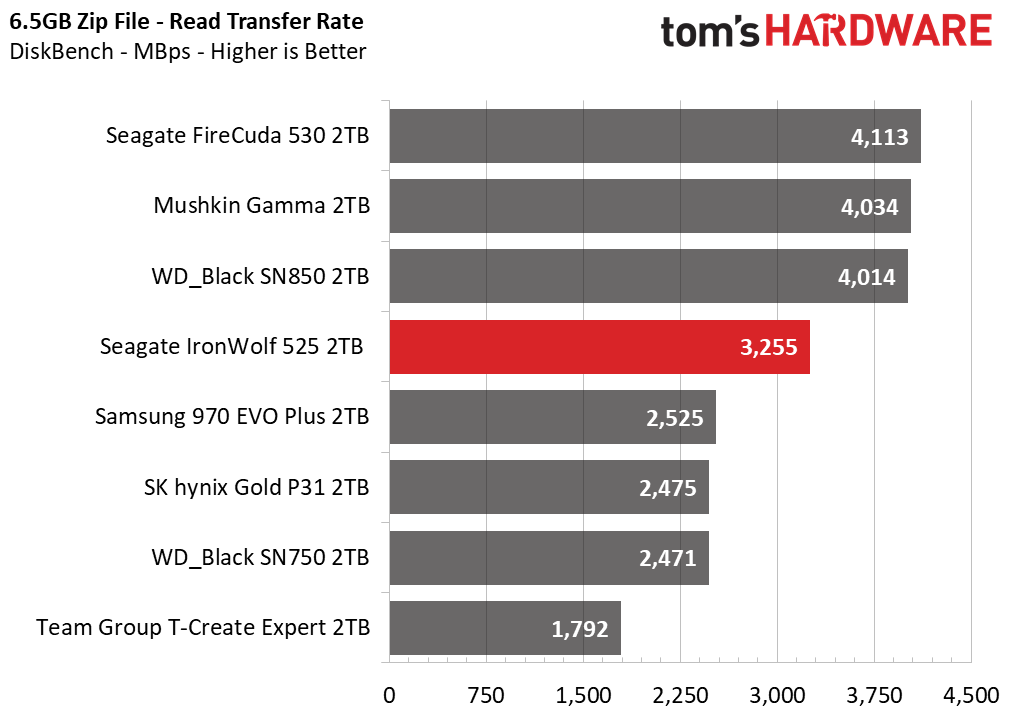
Slower than the Samsung 970 EVO Plus and SK hynix Gold P31, the IronWolf 525 delivered weak copy performance, at least for a PCIe 4.0 SSD. Its read performance proved a bit better, however, exceeding the performance of the PCIe 3.0-equipped SSDs by roughly 30%.
Synthetic Testing - ATTO / CrystalDiskMark
ATTO and CrystalDiskMark (CDM) are free and easy-to-use storage benchmarking tools that SSD vendors commonly use to assign performance specifications to their products. Both of these tools give us insight into how each device handles different file sizes.


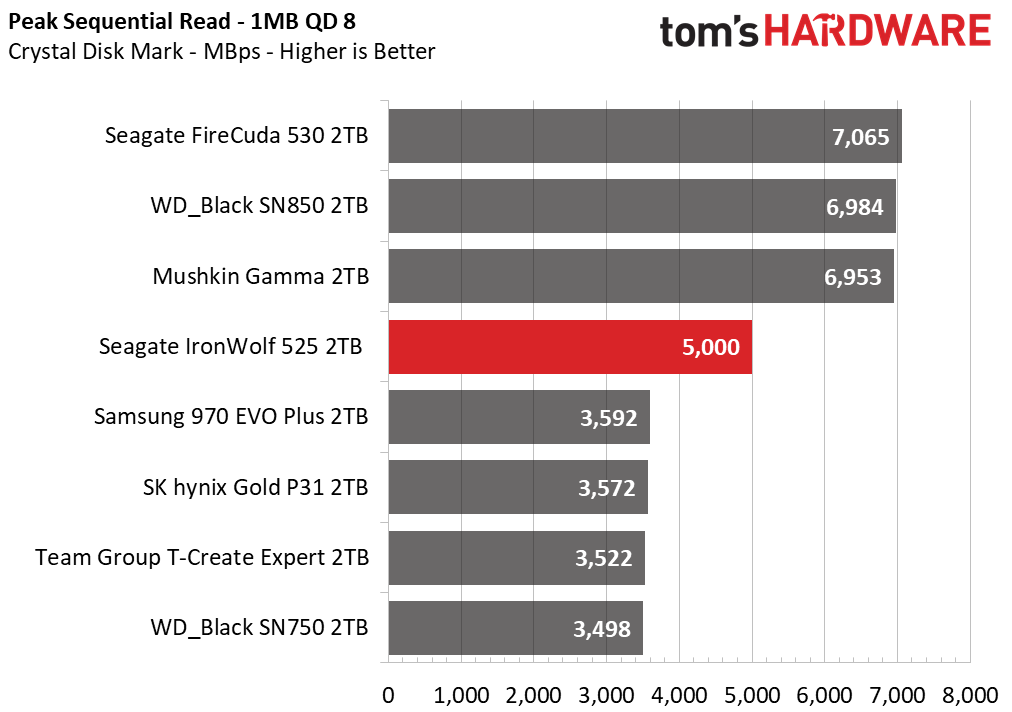
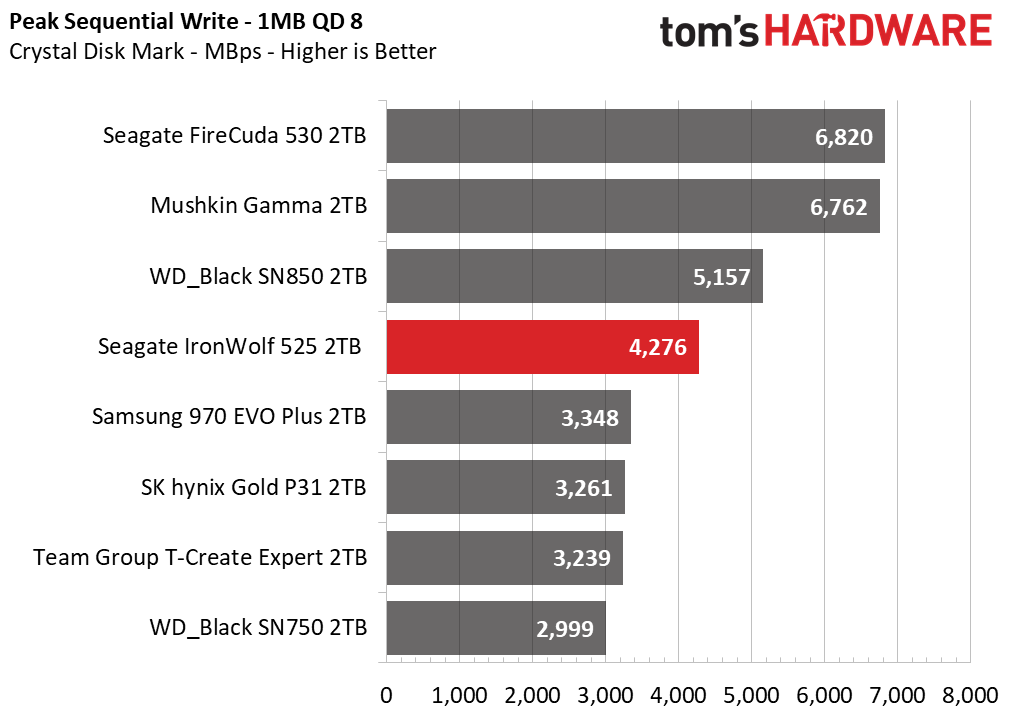

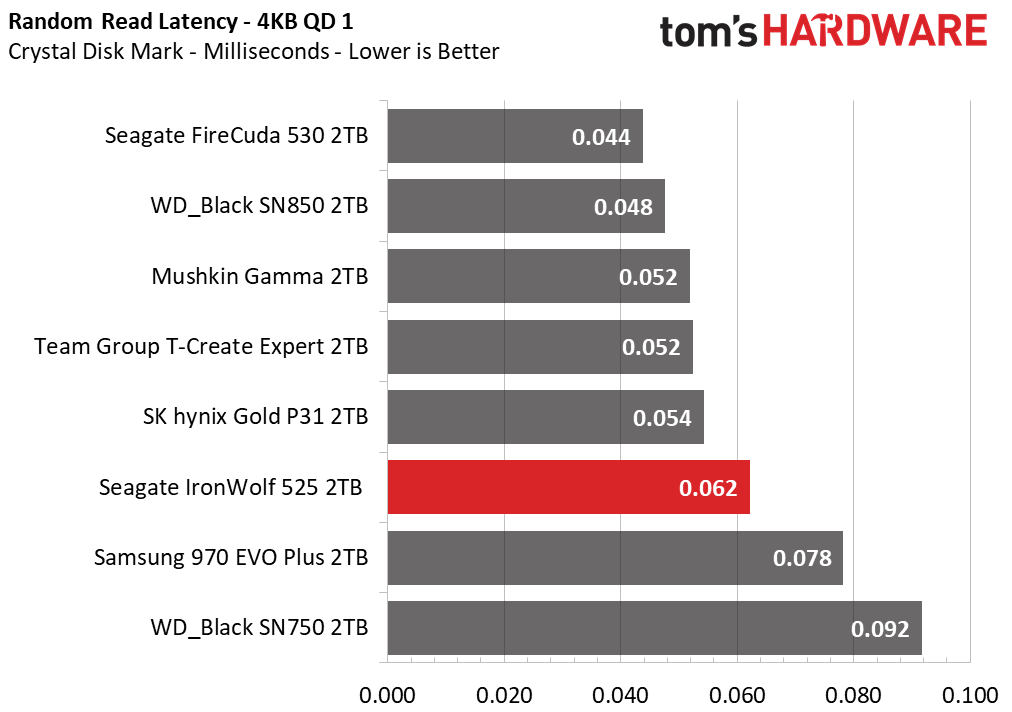

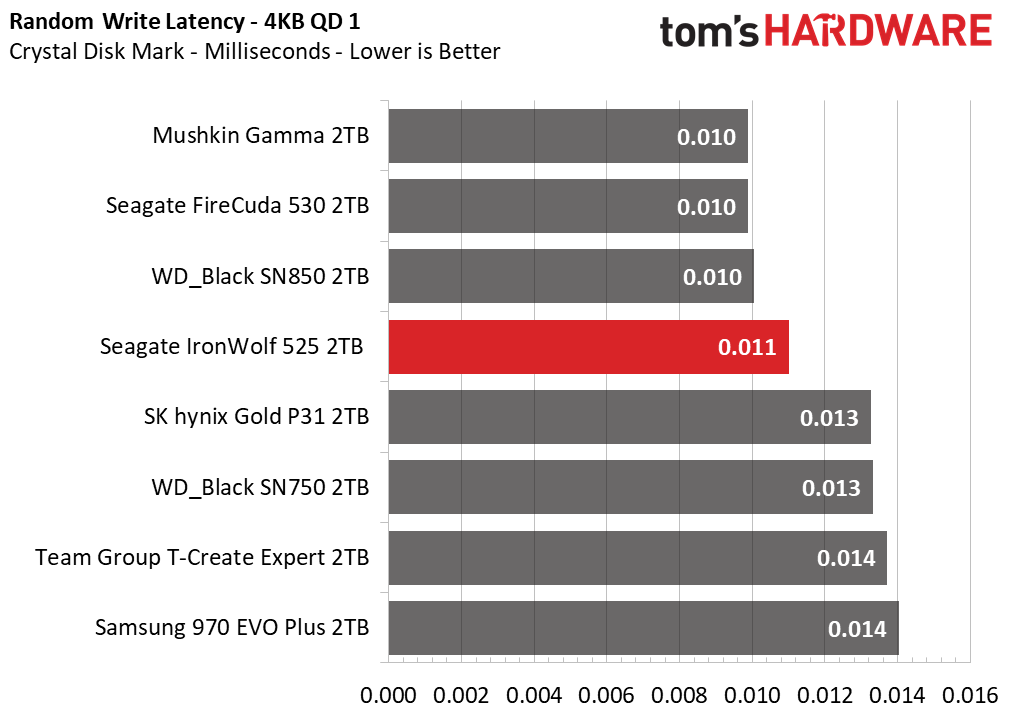



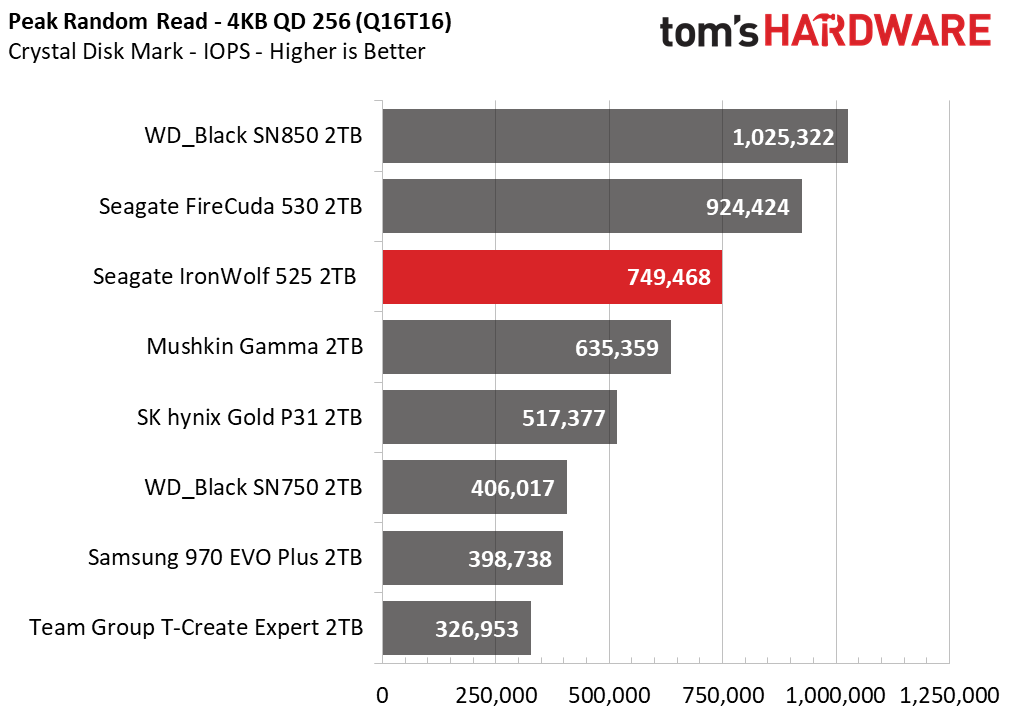
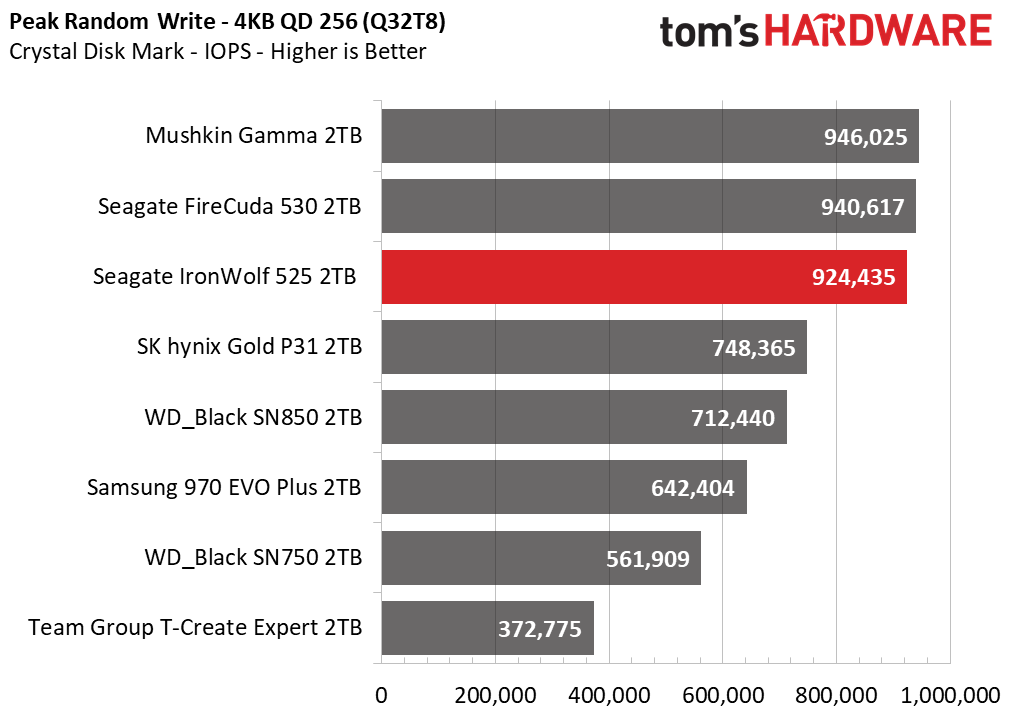
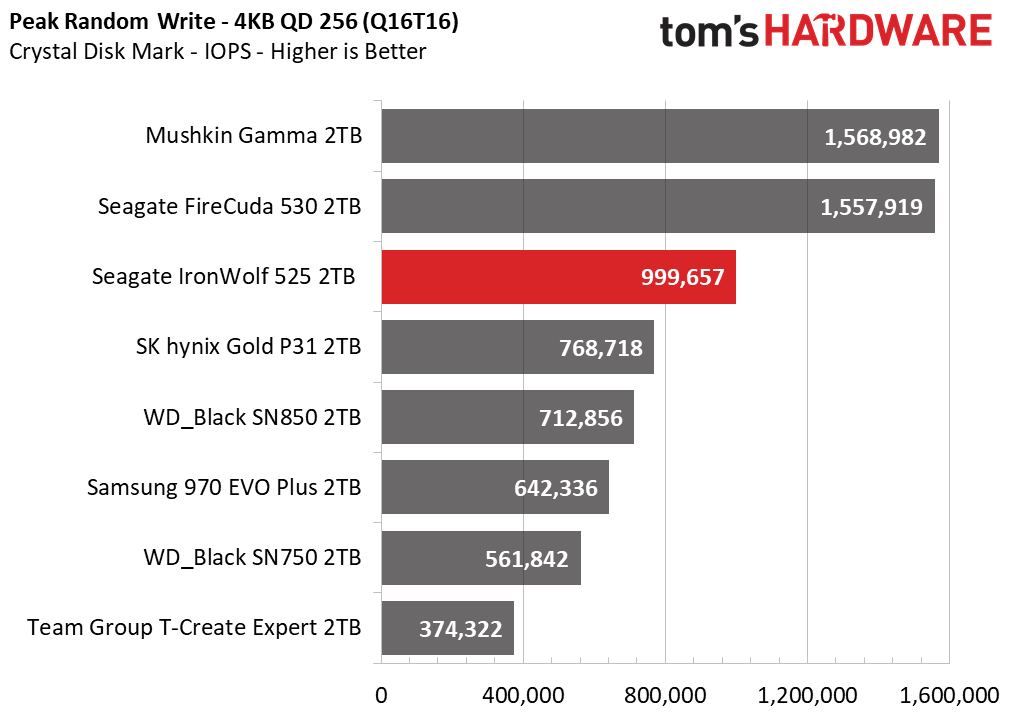
The Seagate IronWolf 525 delivered solid sequential results, but it wasn't as fast as the other PCIe 4.0 SSDs. It also lagged the competition a bit in low-QD random performance, scoring sixth place in our random read test at a queue depth (QD) of 1.
However, after scaling up to QD256, the IronWolf 525 displayed fantastic agility under high pressure and dished out roughly 750,000/1,000,000 random read/write IOPS.
Sustained Write Performance and Cache Recovery
Official write specifications are only part of the performance picture. Most SSDs implement a write cache, which is a fast area of (usually) pseudo-SLC programmed flash that absorbs incoming data. Sustained write speeds can suffer tremendously once the workload spills outside of the cache and into the "native" TLC or QLC flash. We use Iometer to hammer the SSD with sequential writes for 15 minutes to measure both the size of the write cache and performance after the cache is saturated. We also monitor cache recovery via multiple idle rounds.
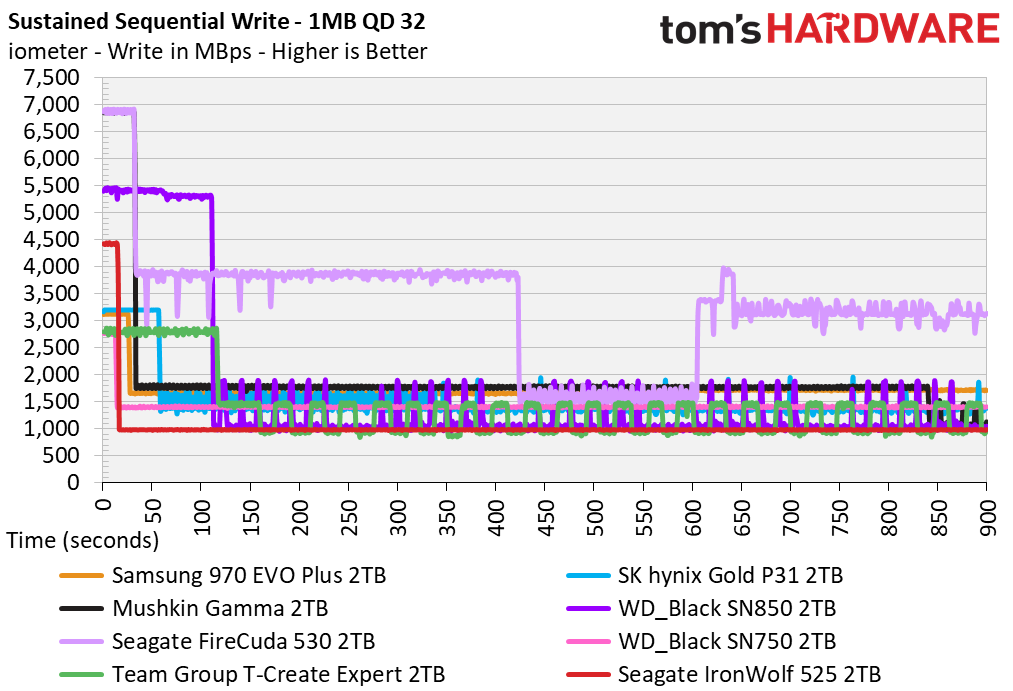



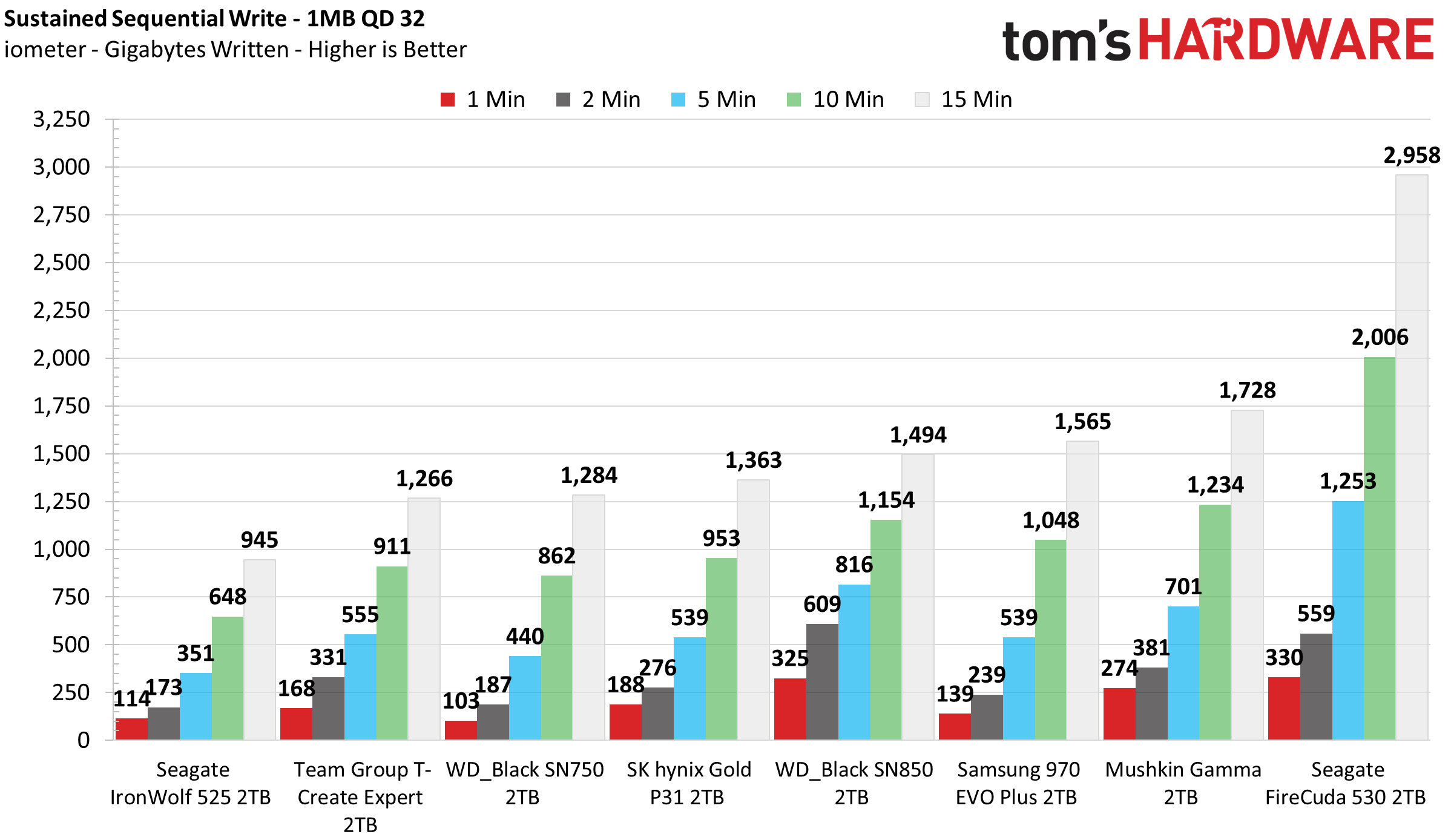
Interestingly, the IronWolf's dynamic SLC behavior varied when pressured with sustained writes. Rather than having a fully dynamic cache that spans one-third of the available capacity, or a small cache like the one found on the Spatium M470, the IronWolf 525's cache was unlike any we have seen from this hardware layout. Seagate's IronWolf 525 SLC caching is dynamic and adjusts based on use.
After hammering it with iometer, the IronWolf 525 absorbed 70GB before degrading from roughly 4.4GBps to 990MBps for the remainder of the test. However, that was just the first pass. During a few of the following write passes, the IronWolf 525's appetite became ferocious, gobbling down roughly 175GB of data before write speed degraded. It was also fairly quick to recover after each idle round, taking roughly 5 minutes to recover 175GB of cache space.
Power Consumption & Temperature
We use the Quarch HD Programmable Power Module to gain a deeper understanding of power characteristics. Idle power consumption is an important aspect to consider, especially if you're looking for a laptop upgrade as even the best Ultrabooks can have mediocre storage.
Some SSDs can consume watts of power at idle while better-suited ones sip just milliwatts. Average workload power consumption and max consumption are two other aspects of power consumption, but performance-per-watt is more important. A drive might consume more power during any given workload, but accomplishing a task faster allows the drive to drop into an idle state more quickly, ultimately saving energy.
We also monitor the drive’s temperature via the S.M.A.R.T. data and an IR thermometer to see when (or if) thermal throttling kicks in and how it impacts performance. Remember that results will vary based on the workload and ambient air temperature.

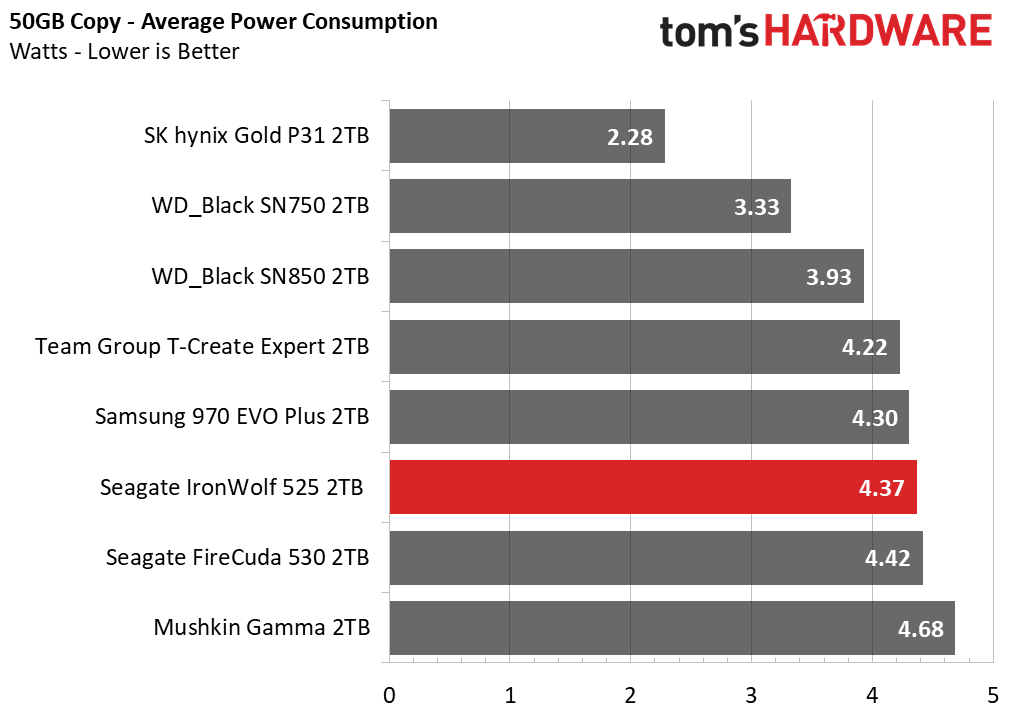
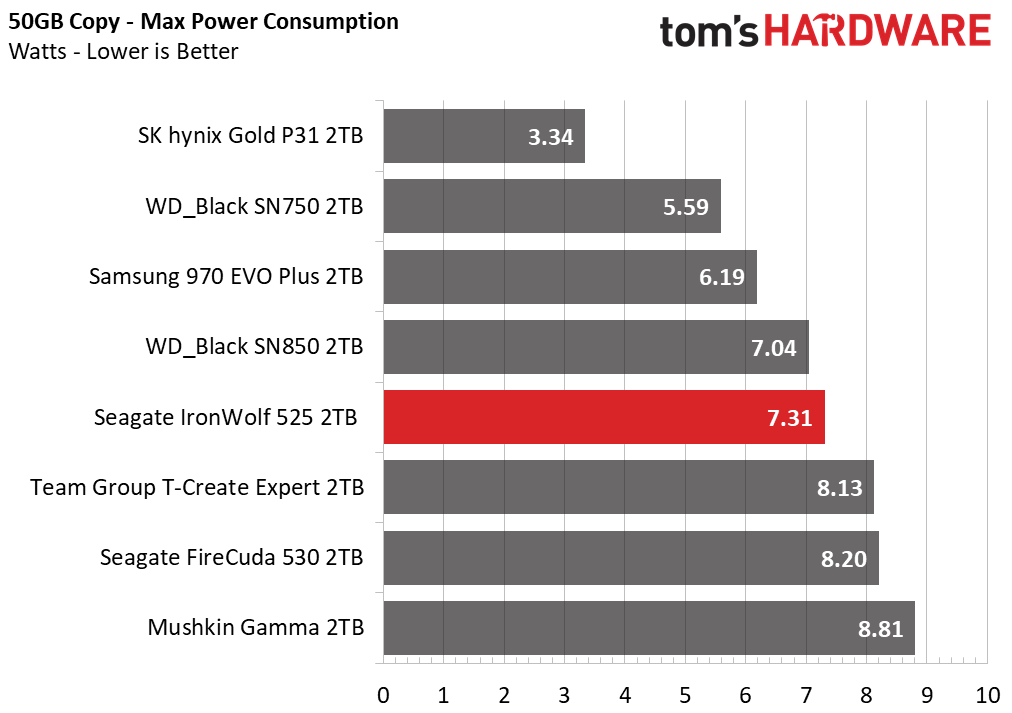
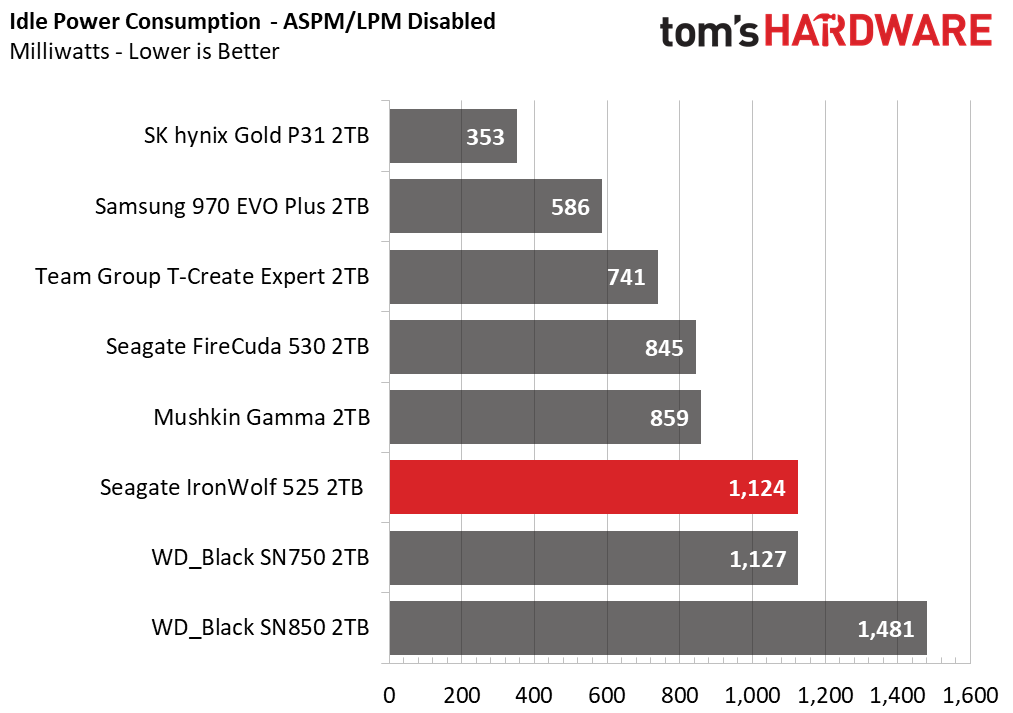
Seagate’s IronWolf 525 consumed quite a bit of power at idle and under load, which led to a second to last place efficiency ranking. Without airflow in our 23 degree Celsius lab, the IronWolf 525’s high power draw led to high idle temperatures on our open-air test bench, measuring in the mid-50s. The Seagate IronWolf 525 began to throttle after roughly 500GB of data was written and the drive reached 83 degrees Celsius. We recommend ensuring adequate cooling if you use the SSD for heavy workloads.
Test Bench and Testing Notes
| CPU | Intel Core i9-11900K |
| Motherboard | ASRock Z590 Taichi |
| Memory | 2x8GB Kingston HyperX Predator DDR4 5333 |
| Graphics | Intel UHD Graphics 750 |
| CPU Cooling | Alphacool Eissturm Hurricane Copper 45 3x140mm |
| Case | Streacom BC1 Open Benchtable |
| Power Supply | Corsair SF750 Platinum |
| OS Storage | WD_Black SN850 2TB |
| Operating System | Windows 10 Pro 64-bit 20H2 |
We use a Rocket Lake platform with most background applications such as indexing, windows updates, and anti-virus disabled in the OS to reduce run-to-run variability. Each SSD is prefilled to 50% capacity and tested as a secondary device. Unless noted, we use active cooling for all SSDs.
Conclusion
Seagate's IronWolf 525 is a faster alternative to its IronWolf 510 and delivers the performance we would expect given its hardware. However, like the recently reviewed MSI Spatium M470, the IronWolf 525 is limited by its older controller. This means its performance lands somewhere between both the best PCIe 3.0 SSDs and PCIe 4.0 SSDs, but it is also a bit inefficient and runs a bit hot without adequate cooling. The company even went as far as to write "CAUTION HOT SURFACE" in bold text on the label.
Although not built for gaming, the IronWolf 525 still delivered responsive performance in 3DMark's Storage Benchmark, which was a pleasant surprise. It also delivered solid results in PCMark 10's Full System Drive Benchmark despite the lower-than-average random 4KB QD1 performance.
With sustained write speeds of nearly 1GBps and burst speeds of up to 5GBps, the IronWolf 525 will deliver solid performance in NAS applications, especially PCIe 4.0-equipped NAS outfitted with multiple 10GbE ports.
If it weren't for the robust endurance rating and three years of Rescue Data Recovery Services, however, Seagate's IronWolf 525 would find itself in an awkward position due to its high price point. For the average user, the cost of the larger capacities is simply out of their league.
The Seagate IronWolf 525 is currently listed at roughly $80-$130 more than the Samsung 980 Pro and WD Black SN850 at 2TB, but to be fair, they lack the endurance and warranty backing.
However, the WD Red SN700 is the IronWolf's more direct competitor. Although it's 'only' a PCIe 3.0 SSD, the WD Red is significantly cheaper at roughly $150 for 2TB, and it still offers plenty of performance and endurance for most NAS applications. Between the two of them, it's hard to say which is better until we review the Red SN700 (which will be soon), but the Red looks to be a better value in terms of price per gigabyte.
The Seagate IronWolf 525's robust warranty, high bandwidth PCIe 4.0 interface, high endurance ratings, and high cost positions it best for small office applications or for those prosumers who see the value in potential data rescue recovery services. If you're on the search for a new NAS SSD for caching, tiering, or just for the sake of simply creating a fast network share on its own, the IronWolf 525 is a solid but costly solution worth considering.
MORE: Best SSDs
MORE: How We Test HDDs And SSDs
MORE: All SSD Content

Sean is a Contributing Editor at Tom’s Hardware US, covering storage hardware.
